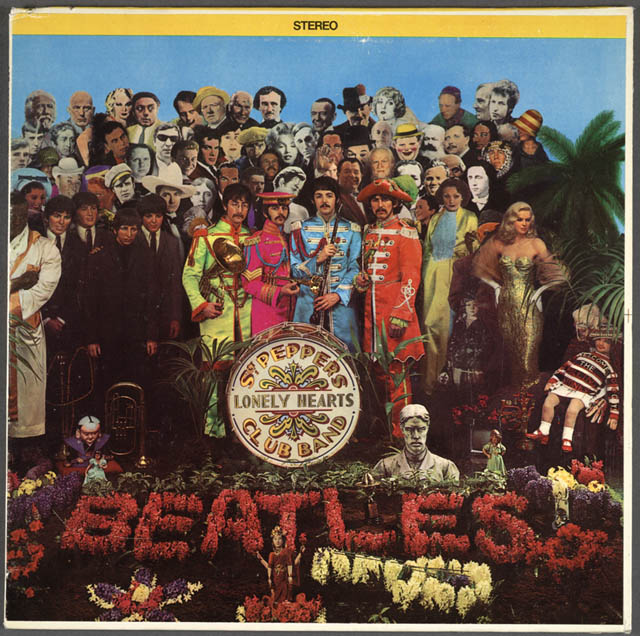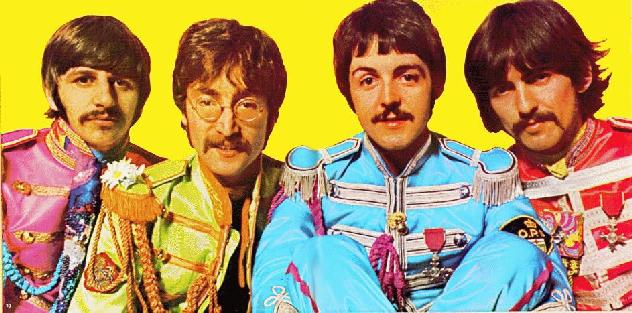
front
cover |
| The musical construction
of Sgt. Pepper's Lonely Hearts Club Band followed the route of
most Beatles albums. John Lennon and Paul McCartney developed songs
on their own, shared them, contributed to each other's compositions,
and took inspiration from the other members of the band. They tried
to have something for Ringo to sing and they allowed George to try out
one of his songs (which at this point were heavily influenced by his
studies of Indian classical music with Pandit Ravi Shankar). Indeed,
this album was very much like their earlier albums, which were capsulizations
of their stage shows. Their stage instincts were still intact and guiding
their aesthetic choices: start and end with something fast, mix slower
love songs and faster dance songs in between the opener and the finale,
mix the keys of songs so you have some harmonic variety, and trade singing
duties so no one gets tired too soon. In general, you want variety and
you want to make a good impression coming on and going off. Of course,
albums had another aspect which paralleled the variety shows in which
the Beatles had performed: you were on twice. That is, in the travelling
variety shows, you played in the first half and the last half. Each
set had to be a subset of and consistent with your entire program. Albums
had two sides. |
| Sgt. Pepper's Lonely
Hearts Club Band has many of these characteristics, and some dramatic
differences too. Sergeant Pepper's band begins with Paul singing its
fast-paced theme song (in G) and ends with and even faster version (F
modulating to G). They then introduce Ringo singing "With a Little Help
from My Friends" (E) and settle into a slow shuffle. When John begins
"Lucy in the Sky with Diamonds" (A) we slip into an even slower tempo
and a waltz before he jolts us with the steady rock of the chorus. Paul's
"Getting Better" (C) picks up the tempo just a bit more. Here, the stage
pattern changes as Paul picks up to more numbers: "Fixing a Hole" (F)
and "She's Leaving Home" (E) sequentially drop the tempo, again moving
from a slow shuffle to a waltz. The side closes with John's mad circus
waltz of "Being for the Benefit of Mr. Kite" (appropriately wavering
between C minor and E minor). |
 |
| Side Two opens with a
shocker. Instead of the rousing opener they often placed at the beginning
of the second side (e.g., "Any Time at All" on A Hard Day's Night),
an Indian tambura's drone accompanies the bowed dilruba introducing
George Harrison's "Within You Without You" (C mixolydian in medium tempo
Tintal, a sixteen-beat time cycle). The recorded theater laughter that
follows the track perhaps reassures the listener that things will be
returning to normal shortly. Paul's "When I'm Sixty Four" (C) with its
comforting clarinets and twenties-style foxtrot puts us firmly back
in the music hall with its comforting images of retirees in their country
cottage. As though to show us where the couple met, he picks up the
tempo and continues with "Lovely Rita" (Eb). The last act on the program
is the comedian. Lennon wakes us with a rooster crowing and "Good Morning
Good Morning" (A) with its jolting rock in 5/4 (with a few measures
of 3/4 and 4/4 just to keep us off-balance) that leaves us staggering,
crashing a cymbal as the satirist hits his mark. As he leaves the stage,
he brings his menagerie with him, each chasing and being chased. The
finale version of the theme song is faster than the original and features
the classic pop-song device of modulating up a whole tone (again, F
modulating to G). McCartney thanks us all for being the audience and
that it's time to go. However, as we leave the theater and the night
air hits us, we become sober. The music is still with us (G major),
but, along with the comedian, now alone backstage, we re-enter reality.
The newspaper reminds us of our mundane existence and of our own vulnerability.
This is not the shouting and screaming of "Twist and Shout." Like "Tomorrow
Never Knows" on Revolver before it, Sgt. Pepper's, the album
of the decade, ends with a descent into a hallucinogenic escape. We
end with E major ringing in our ears until the inner groove's nonsense
loop finally wakes us from the trance. |
| Lewisohn (1988:107) notes
that the Beatles played with the order of side A. At one point in early
April, the following was the plan. |